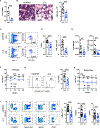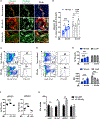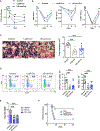Distinct Bone Marrow Sources of Pleiotrophin Control Hematopoietic Stem Cell Maintenance and Regeneration
- PMID: 30100167
- PMCID: PMC6482945
- DOI: 10.1016/j.stem.2018.07.003
Distinct Bone Marrow Sources of Pleiotrophin Control Hematopoietic Stem Cell Maintenance and Regeneration
Abstract
Bone marrow (BM) perivascular stromal cells and vascular endothelial cells (ECs) are essential for hematopoietic stem cell (HSC) maintenance, but the roles of distinct niche compartments during HSC regeneration are less understood. Here we show that Leptin receptor-expressing (LepR+) BM stromal cells and ECs dichotomously regulate HSC maintenance and regeneration via secretion of pleiotrophin (PTN). BM stromal cells are the key source of PTN during steady-state hematopoiesis because its deletion from stromal cells, but not hematopoietic cells, osteoblasts, or ECs, depletes the HSC pool. Following myelosuppressive irradiation, PTN expression is increased in bone marrow endothelial cells (BMECs), and PTN+ ECs are more frequent in the niche. Moreover, deleting Ptn from ECs impairs HSC regeneration whereas Ptn deletion from BM stromal cells does not. These findings reveal dichotomous and complementary regulation of HSC maintenance and regeneration by BM stromal cells and ECs.
Keywords: endothelial cells; hematopoiesis; microenvironment; niche; pleiotrophin; regeneration; self-renewal; stem cells.
Copyright © 2018 Elsevier Inc. All rights reserved.
Conflict of interest statement
DECLARATION OF INTERESTS
The authors declare no competing interests.
Figures





References
-
- Alva JA, Zovein AC, Monvoisin A, Murphy T, Salazar A, Harvey NL, Carmeliet P, and Iruela-Arispe ML (2006). VE-Cadherin-Cre-recombinase transgenic mouse: a tool for lineage analysis and gene deletion in endothelial cells. Dev. Dyn 235, 759–767. - PubMed
-
- Cashman JD, and Eaves CJ (1999). Human growth factor-enhanced regeneration of transplantable human hematopoietic stem cells in nonobese diabetic/severe combined immunodeficient mice. Blood 93, 481–487. - PubMed
Publication types
MeSH terms
Substances
Grants and funding
LinkOut - more resources
Full Text Sources
Other Literature Sources
Medical
Molecular Biology Databases
Miscellaneous

